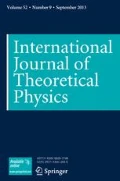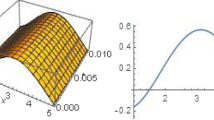Abstract
The mixed spin-1 and spin-3/2 Blume-Emery-Griffiths model with attractive biquadratic coupling is investigated in the framework of the Migdal-Kadanoff Renormalization Group method. By changing the ratio R > 0 of biquadratic and bilinear exchange interactions and according to the different values of crystal field interactions, we have determined six main types of phase diagrams. The full flow in the parameters space of the Hamiltonian was established and the fixed points obtained are drawn up in a table. In addition, we have determined the eigenvalues of the transformation of the group in the vicinity of the critical points. Finally, the introduction of a positive biquadratic interaction was discussed.









Similar content being viewed by others
References
Blume, M., Emery, V.J., Griffiths, R.B.: Phys. Rev. A. 4, 1071 (1971)
Newman, K.E., Dow, J.D.: Phys. Rev. B. 27, 7495 (1983)
Lajzerowicz, J., Sivardière, J.: 11, 2090 (1975); 11, 2101 (1975). Phys. Rev. A. 11, 2079 (1975)
Schick, M., Shih, W.H.: Phys. Rev. B. 34, 1797 (1986)
Berker, A.N., Ostlund, S., Putuam, F.A.: Phys. Rev. B. 17, 3650 (1978)
Berker, A.N., Wortis, M.: Phys. Rev. B. 14, 4946 (1976)
Hoston, W., Berker, A.N.: Phys. Rev. Lett. 67, 1027 (1991)
Bakchich, A., El Bouziani, M.: Phys. Rev. B. 56, 11155 (1997)
Sivardière, J., Blume, M.: Phys. Rev. B. 5, 1126 (1972)
Krinsky, S., Mukamel, D.: Phys. Rev. B. 11, 399 (1975)
Sá Barreto, F.C., De Alcantara Bonfim, O.F.: Physica A. 172, 378 (1991)
Kaneyoshi, T., Jaščur, M.: Phys. Lett. A. 177, 172 (1993)
Bakchich, A., Bassir, A., Benyoussef, A.: Physica A. 195, 188 (1993)
Bakchich, A., El Bouziani, M.: J. Phys.: Cond. Matter. 13, 91 (2001)
Kahn, O.: Molecular Magnetism. VCH, New York (1993)
Tabasum, M.R., Zighem, F., De La Torre Medina, J., Encinas, A., Piraux, L., Nysten, B.: Nanotechnology. 25, 245707 (2014)
Prinz, G.A.: Science. 282, 1660 (1998)
Stanica, N., Stager, C.V., Cimpoesu, M., Andruh, M.: Polyhedron. 17, 1787 (1998)
Albayrak, E.: Physica A. 375, 174 (2007)
Karimou, M., Yessoufou, R., Hontinfinde, F., Cond, W.J.: Matt. Phys. 5, 187 (2015)
Yessoufou, R.A., Bekhechi, S., Hontinfinde, F.: Eur. Phys. J. B. 81, 137 (2011)
Jabar, A., Belhaj, A., Labrim, H., Bahmad, L., Hassanain, N., Benyoussef, A.: Superlatt. Microstruct. 78, 171 (2014)
Sidi Ahmed, S., Bahmad, L., Benyoussef, A., El Kenz, A.: Superlatt. Microstruct. 109, 841 (2017)
Sidi Ahmed, S., Bahmad, L., El Yousfi, A., Benyoussef, A., El Kenz, A., El Hachimi, A.G.: Superlatt. Microstruct. 123, 1 (2018)
Alrajhi, A., Hachem, N., Lafhal, A., El Antari, A., El Bouziani, M., Madani, M., El Falaki, M.: J. Adv. Phys. 7, 261 (2018)
Migdal, A.A., Eksp, Z.: Sov. Phys. JETP 42, 743 (1975). Teor. Fiz. 69, 810 (1975)
Kadanoff, L.P.: Ann. Phys. (NY). 100, 359 (1976)
Madani, M., Gaye, A., El Bouziani, M., Alrajhi, A.: Physica A. 437, 396 (2015)
Hasenbusch, M.: Phys. Rev. B. 82, 174433 (2010)
Hachem, N., Lafhal, A., Zahir, H., El Bouziani, M., Madani, M., Alrajhi, A.: Superlatt. Microstr. 111, 927 (2017)
Lipowsky, R., Wagner, H., Phys, Z.: B - Condens. Matter. 42, 355 (1981)
Nienhuis, B., Nauenberg, M.: Phys. Rev. Lett. 35, 477 (1975)
Blume, M.: Phys. Rev. 141, 517 (1966)
Capel, H.W.: Physica. 32, 966 (1966)
Abubrig, O.F., Horváth, D., Bobák, A., Jaščur, M.: Physica A. 296, 437 (2001)
Bourass, M., Zradba, A., Zouhair, S., El Antari, A., El Bouziani, M., Madani, M., Alrajhi, A.: J. Supercond. Nov. Magn. 31, 541 (2018)
El Antari, A., Zahir, H., Hasnaoui, A., Hachem, N., Alrajhi, A., Madani, M., El Bouziani, M.: Inter. J. Theor. Phys. 57, 2330 (2018)
Lafhal, A., Hachem, N., Zahir, H., El Bouziani, M., Madani, M., Alrajhi, A.: J. Stat. Phys. 174, 40 (2019)
Author information
Authors and Affiliations
Corresponding author
Additional information
Publisher’s Note
Springer Nature remains neutral with regard to jurisdictional claims in published maps and institutional affiliations.
Appendix
Appendix
-
The fixed point C* of second-order transition:
In the vicinity of the fixed point C* of second-order transition, we have the following relations:
Taking into account the relations between the interactions (11), the recursion Eqs. (4) are reduced to:
This leads to the coordinates of the fixed point C* as shown in Table 2; for d = 2: C∗(1.5639; 0; +∞; −∞; −0.4812) and for d = 3: C∗(0.7674; 0; +∞; −∞; −0.2361).
In order to calculate the eigenvalues corresponding to the fixed point C*, we diagonalize the associated matrix M:
where the derivatives are calculated at the fixed point C*. Therefore, the eigenvalues found are: λ1 = 3, λ2 = 2.25 and λ3 = 0.75 for d = 2, and λ1 = 9, λ2 = 2.7659 and λ3 = 0.9219 for d = 3 (Table 3).
The Fixed Point T* Representing the Tricritical Points
The flow is very instable in the vicinity of the fixed point T*, which does not allow us to find relations between the interactions. For this reason, the coordinates of the point T* are obtained numerically, and the eigenvalues of the matrix M in the vicinity of T* are also calculated using a numerical program.
As shown in Table 2, we found the following coordinates of the fixed point T*: T∗(−0.29; 0.83; −16.8; −1.74; 1.16) for d = 2 and T∗(0.70; 1.91; −71.07; 1.71; 2.79) for d = 3.
In addition, our program gives the following eigenvalues as presented in Table 3: λ1 = 8.2140, λ2 = 2.7061, λ3 = 0.2627, λ4 = 0.1541 and λ5 = 0.0739 for d = 2, and λ1 = 13.4695, λ2 = 8.9425, λ3 = 0.0039, λ4 = −0.0009 and λ5 = −0.00005 for d = 3.
Rights and permissions
About this article
Cite this article
Lafhal, A., El Antari, A., Hachem, N. et al. Renormalization Group Study of the Mixed Spin-1 and Spin-3/2 Blume-Emery-Griffiths Model with Attractive Biquadratic Coupling. Int J Theor Phys 59, 1165–1178 (2020). https://doi.org/10.1007/s10773-020-04396-2
Received:
Accepted:
Published:
Issue Date:
DOI: https://doi.org/10.1007/s10773-020-04396-2




